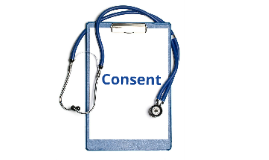PBL - Vignette Presentation
Transcript: Consent Pauline Shapton, Jake Boland, Michael Ng, Melanie England When DO you need consent? When do you NOT require consent? CNO Guideline Health Care Providers do NOT require consent for: (College of Nurses of Ontario, 2009) Client indrectly accept or refuse the proposed treatment based on their actions Canada, Provincial. (1996). Health Care Consent Act. Retrieved from: http://www.elaws.gov.on.ca/html/statutes/english/elaws_statutes_96h02_e.htm#Top treatments admission required by law optional for personal assistance services Questions? Substitute Decision Act emergencies crisis situations Skit College of Nurses of Ontario. (2009). Consent. Practice Guideline. Received from: http://www.cno.org/Global/docs/policy/41020_consent.pdf (College of Nurses of Ontario, 2009) Agenda considered incapable if: Canada, Provincial. (1992). Substitute Decision Act. Retrieved from: http://www.elaws.gov.on.ca/html/statutes/english/elaws_statutes_92s30_e.htm -written -oral -implied Consent is informed if: the person received the information about the treatment that a reasonable person in the same circumstances would require to make a decision; and the person received responses to his/her requests for additional information about the treatment. Health Care Consent Act - nurses have an ethical and legal obligation for obtaining consent - Steps for obtaining consent: 1. Assess capacity 2. Provide emergency treatment or crisis admission 3. Inform the client that a substitute decision maker will make the verdict 4. Identify a substitute decision maker 5. Obtain consent from the substitute decision maker The client directly accepts health care by signing a consent form for the specific care Oral Consent Definition they do not understand the relevant information or if they are unable to comprehend the possible consequences of the decision 1. Guardian of the person — appointed by the court. 2. Someone who has been named as an attorney for personal care. 3. Someone appointed as a representative by the CCB. 4. Spouse, partner or relative in the following order: a. spouse or partner, b. child if 16 or older; custodial parent(who can be younger than 16 years old if the decision is being made for the substitute’s child); or Children’s Aid Society; c. parent who has only a right of access; d. brother or sister; e. other relative. 5. PGT is the substitute decision-maker of last resort in the absence of any more highly ranked substitute I am confused about something. Today, an 8 year old girl came in, with an anaphylactic reaction to peanuts. She had a teacher with her, but her parents were not there. We went ahead and started an IV and gave her some meds, but there was no parent to consent. Should we have gotten consent from the teacher? Or waited for the family? Is she able to give consent for herself? References HCCA Written Consent Making Decisions for Others. (2009). Hamilton Health Sciences, 1-8. The client verbally initiates consent for health care (College of Nurses of Ontario, 2009) College of Nurses of Ontario/Ordre des Infirmières et Infirmiers de l'Ontario. (2012, July 25). Consent. Retrieved November 12, 2012, from http://www.cno.org/en/learn-about-standards-guidelines/educational-tools/learning-modules/consent/ concerned with those who requires decisions made on their behalf on a continuous basis A person identified by the HCCA who may make a treatment decision for someone who is incapable of making their own decision Implied Consent Potter, P.A., & Perry, A.G. (2010). Foundations of Nursing Practice. In J. Burger & N. Goddard (Eds.), Canadian fundamentals of nursing. (Rev. 4th ed.). Toronto, ON: Mosby An individual is Types of Consent Hierarchy of Substitute Decision Makers Vignette Health Care Providers require consent for: -Scenario/vignette -definition of consent -CNO guideline -HCCA legislation -Hierarchy of substitute decision-maker -SDA legislation -Skit : large group/small group discussion Promoting individual authority and autonomy facilitating communication between health care practitioners and their clients ensuring a significant role for family members when the client is incapable of providing consent

















